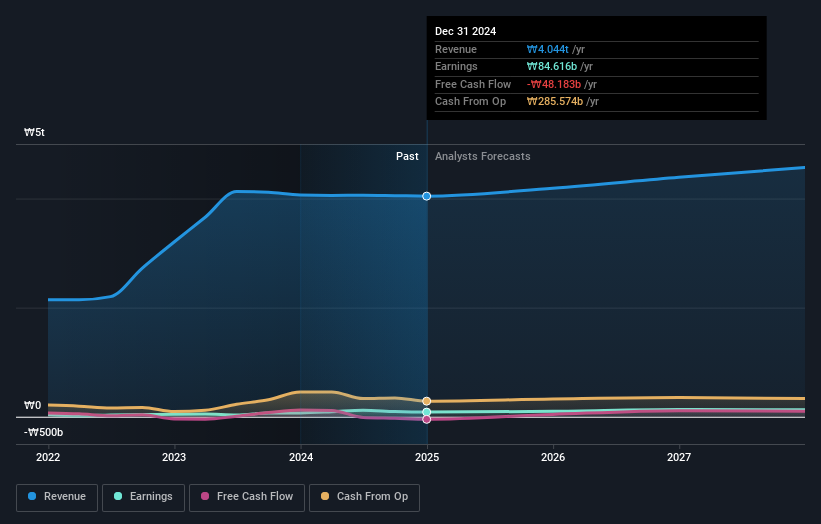Lotte Wellfood Co.,Ltd's (KRX:280360) market cap touched ₩1.1t last week, benefiting both public companies who own 51% as well as institutions
Key Insights
- Lotte WellfoodLtd's significant public companies ownership suggests that the key decisions are influenced by shareholders from the larger public
- LOTTE Corporation owns 51% of the company
- Institutions own 20% of Lotte WellfoodLtd
To get a sense of who is truly in control of Lotte Wellfood Co.,Ltd (KRX:280360), it is important to understand the ownership structure of the business. The group holding the most number of shares in the company, around 51% to be precise, is public companies. Put another way, the group faces the maximum upside potential (or downside risk).
Following a 11% increase in the stock price last week, public companies profited the most, but institutions who own 20% stock also stood to gain from the increase.
In the chart below, we zoom in on the different ownership groups of Lotte WellfoodLtd.
Check out our latest analysis for Lotte WellfoodLtd

What Does The Institutional Ownership Tell Us About Lotte WellfoodLtd?
Many institutions measure their performance against an index that approximates the local market. So they usually pay more attention to companies that are included in major indices.
Lotte WellfoodLtd already has institutions on the share registry. Indeed, they own a respectable stake in the company. This suggests some credibility amongst professional investors. But we can't rely on that fact alone since institutions make bad investments sometimes, just like everyone does. When multiple institutions own a stock, there's always a risk that they are in a 'crowded trade'. When such a trade goes wrong, multiple parties may compete to sell stock fast. This risk is higher in a company without a history of growth. You can see Lotte WellfoodLtd's historic earnings and revenue below, but keep in mind there's always more to the story.

Lotte WellfoodLtd is not owned by hedge funds. The company's largest shareholder is LOTTE Corporation, with ownership of 51%. With such a huge stake in the ownership, we infer that they have significant control of the future of the company. National Pension Service is the second largest shareholder owning 8.1% of common stock, and Lotte Aluminium Co., Ltd. holds about 7.3% of the company stock.
While it makes sense to study institutional ownership data for a company, it also makes sense to study analyst sentiments to know which way the wind is blowing. Quite a few analysts cover the stock, so you could look into forecast growth quite easily.
Insider Ownership Of Lotte WellfoodLtd
The definition of an insider can differ slightly between different countries, but members of the board of directors always count. The company management answer to the board and the latter should represent the interests of shareholders. Notably, sometimes top-level managers are on the board themselves.
Most consider insider ownership a positive because it can indicate the board is well aligned with other shareholders. However, on some occasions too much power is concentrated within this group.
Shareholders would probably be interested to learn that insiders own shares in Lotte Wellfood Co.,Ltd. As individuals, the insiders collectively own ₩42b worth of the ₩1.1t company. Some would say this shows alignment of interests between shareholders and the board. But it might be worth checking if those insiders have been selling.
General Public Ownership
The general public, who are usually individual investors, hold a 12% stake in Lotte WellfoodLtd. While this size of ownership may not be enough to sway a policy decision in their favour, they can still make a collective impact on company policies.
Private Company Ownership
Our data indicates that Private Companies hold 14%, of the company's shares. It's hard to draw any conclusions from this fact alone, so its worth looking into who owns those private companies. Sometimes insiders or other related parties have an interest in shares in a public company through a separate private company.
Public Company Ownership
It appears to us that public companies own 51% of Lotte WellfoodLtd. We can't be certain but it is quite possible this is a strategic stake. The businesses may be similar, or work together.
Next Steps:
I find it very interesting to look at who exactly owns a company. But to truly gain insight, we need to consider other information, too. For example, we've discovered 1 warning sign for Lotte WellfoodLtd that you should be aware of before investing here.
But ultimately it is the future, not the past, that will determine how well the owners of this business will do. Therefore we think it advisable to take a look at this free report showing whether analysts are predicting a brighter future.
NB: Figures in this article are calculated using data from the last twelve months, which refer to the 12-month period ending on the last date of the month the financial statement is dated. This may not be consistent with full year annual report figures.
Have feedback on this article? Concerned about the content? Get in touch with us directly. Alternatively, email editorial-team (at) simplywallst.com.
This article by Simply Wall St is general in nature. We provide commentary based on historical data and analyst forecasts only using an unbiased methodology and our articles are not intended to be financial advice. It does not constitute a recommendation to buy or sell any stock, and does not take account of your objectives, or your financial situation. We aim to bring you long-term focused analysis driven by fundamental data. Note that our analysis may not factor in the latest price-sensitive company announcements or qualitative material. Simply Wall St has no position in any stocks mentioned.
 Wall Street Journal
Wall Street Journal